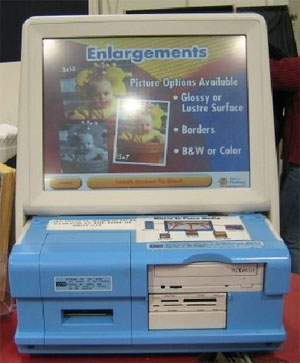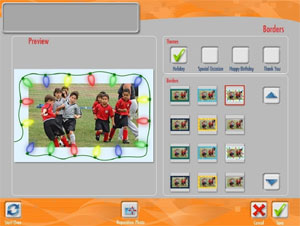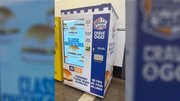Article
Take a picture ... it'll last longer
In a report recently released by Summit Research Associates, 22 photo kiosk models are compared side-by-side. The findings of the report - coupled with some insight from industry leaders - cast some light on where the business may be going.
May 2, 2005 by James Bickers — Editor, Networld Alliance
As president of Summit Research Associates, a research firm devoted to the kiosk business, Francie Mendelsohn keeps her ear to the ground when it comes to new possibilities and rumblings off in the distance. She's still delighted by the success that photo kiosks have attained, relatively early in their lifespan.
"Photo kiosks already comprise almost 25 percent of all kiosks installed," she said, "which is just incredible."
Greg Swistak, executive director of Kiosks.org Association, agrees.
"It will be a while before we find another killer app like this one," he said. "Many companies are gearing up to place small photo kiosks in new locations like resorts, hotels, c-stores, even apartments and colleges."
Summit recently published its "Kiosk Industry Sector Report: Digital Photography," which puts 22 different photo kiosk models through a rigorous battery of tests and comparisons. The report also offers some interesting bits of information about the digital photo market as a whole; for instance, women are not only the primary users of photo kiosks but are the primary purchasers of digital cameras, as well.
Digital cameras were the big Christmas gift the last two holiday seasons, and are increasingly supplanting film models as the "family camera"; this trend will continue to push consumers toward the most convenient method of getting prints. Those cameras are getting more sophisticated with each iteration, too: According to the Summit report, 40 percent of all digital camera purchases are replacements for other digital cameras, not traditional film ones - and people are spending more on average for each new camera.
Getting it on paper
The digital camera has prompted a quantum shift in the way consumers think about their photos. In the days of film, exposures were counted and conserved, shutterbugs careful not to waste film. With the ability to delete bad pictures on the fly, the concept of a "wasted shot" has become obsolete, and more and more people are snapping more and more pictures, many pictures that they might never have taken with a film camera.
The result, naturally, is that there are many more pictures sitting on hard drives and media sticks than anyone intends to print. According to a report by the Photo Marketing Association International, 9.4 billion digital photos went unprinted in 2004. While many (if not most) of those 9.4 billion images were likely blurry, accidentally taken or worthless for some other reason, some of them undoubtedly represent potential prints.
 |
Costco's photo kiosk (photo courtesy Summit Research Associates) |
Whether they are soccer moms or professional photographers, digital camera users have a small handful of options when it comes time to get prints: they can print them at home, upload them to an online photo service, or take them to a kiosk.
"The market to deliver hard-copy prints of photos, while significant, is a fixed number of prints," Swistak said. "All of the producers compete for this market."
Swistak said that while home printers offer convenience, as well as built-in appeal for do-it-yourself personality types, they are much more expensive than other options, and the results are not usually fade- or water-resistant. Online services can be inexpensive, but won't appeal to people who want their pictures right away.
"Kiosks provide immediate gratification," he said.
Making it simple
Not surprisingly, simplicity is a recurring theme when it comes to photo kiosks - and it figures prominently in the Summit report. In the section "Top Ten Tips for Successfully Deploying Photo Kiosks," ease of use ranks No. 1.
"Ease of use trumps feature glut any day," said Gary Pageau, group executive for content development with PMAI. "(That) includes simple methods of payment, clear instructions and having sufficient space for the busy shopper to lay out their prints and work."
One of the biggest challenges for the photo kiosk designer is meeting the needs of the end-user - especially since the end user might be a professional photographer, or might be a mom or dad who just wants some pictures of the kids to send to the grandparents. According to Laura Oles, vice president of strategic communications for Pixel Magic Imaging, it is important to get to know your user base before planning features.
"The right photo kiosk can appeal to both categories of consumer," she said. "Advanced users can take advantage of cropping and enhancement tools while casual users benefit from the auto-enhancement features. Â… If a user is really hardcore, it's very possible he's made all his edits prior to bringing the image to the kiosk anyway."
Tools like red-eye reduction seem like no-brainers. "It's hard to imagine when red-eye would be desired," Pageau said.
Yet while 83 percent of the kiosks profiled in the Summit report offer red-eye reduction, only 48 percent offer auto-enhancement or correction.
"I've seen some of these where you manually move the crosshairs over each of the pupils to remove red eye," Mendelsohn said. "That just takes too long. There are certainly technologies that let you do that automatically. Auto-correction is another nice feature - and again, why wouldn't you want it?"
 |
Signifi's QuickPIX allows users to add custom borders to photos. (photo courtesy Summit Research Associates) |
Rob Howard, manager of marketing communications for Signifi Solutions, said that automation is key, but only if the feature being automated is a good one. For instance, auto-reduction of red-eye or auto-correction of brightness and contrast levels could have a negative effect on some images, if the algorithms used aren't accurate.
"The balance lies between the power of the feature and how easy it is for the customer to use it to achieve the desired result," he said. "Yes, features like red-eye reduction should be automated, but only based on the accuracy of the feature to deliver the expected outcome."
The most prevalent feature Summit found in its research was cropping and zooming, which is offered in 87 percent of the kiosks surveyed. Other popular features include brightness adjustment, black/white and sepia conversion, and the ability to add borders and text.
Manufacturers and designers have grappled with the challenge of making a machine that works for both pro and amateur. How many features are too many? How can an interface appeal to two such different demographics?
According to Mendelsohn, such a perfect balance can be achieved, but it requires a synergy of both excellent design and excellent components.
"Costco is a great example," she said. "Professional photographers come in there all the time to get their 8x10 and 11x14 prints produced because the Noritsu minilab produces prints of exceptional quality at very low cost. Lots of soccer moms come in to get prints of the latest batch of pictures they've shot. Everybody's happy."
Swistak cautions that for a kiosk to appeal to the professional, the bar has to be set pretty high.
"Calibration at the local drug store may be perfectly acceptable for the soccer mom, but the discerning eye of the professional can distinguish differences," he said. "Professionals may also be seeking different quality papers that are not widely available."
An online fight?
So what about online services? Do offerings from Snapfish, Wal-Mart and HP Photo represent a threat to the kiosk?
"I think their niche is file-sharing, while the kiosks are better at instant printing and archival," Mendelsohn said. "I think both alternatives can survive and thrive." She also said that the quality of online photo services can be lower than that of a typical kiosk, "sometimes several notches below."
"The online companies have been around as long as the kiosks - Kodak, for example, offers both options," Swistak said. "It seems that both markets are growing along with digital camera use without taking share from each other."
Swistak said that online photo processors are strong when it comes to the number of products they can offer - everything from coffee mugs to tote bags - as well as the ability to store images for future reprints. But he's not worried about the photo kiosk.
"Consumers sort out what is most valuable to them," he said. "To the consumer, the most important features are cost, simplicity, speed and durability."
Pixel Magic's Oles agrees. "We see online photo processing as a complement rather than a threat," she said. "Digital photography has created a renewed interest in photography as a whole, and we see the two components working in tandem."
What's next
The next great innovation in digital photography will likely come from a device that most of us already have in our pockets - the cell phone.
Early camera phones, with their low resolutions, were little more than novelties. But according to Mendelsohn, as the quality continues to improve, we're likely to see the camera phone become the primary camera.
"Just watch out," Mendelsohn said. "In Japan, historically they snap pictures like crazy. They've moved over to camera phones with a vengeance. The camera phones in Asia are now 4- and 5-megapixel, and Samsung introduced a 7-megapixel camera phone. You can start taking some pretty good stuff!"
It looks like many photo kiosks are ready for this particular revolution: According to the Summit report, 87 percent of the machines are equipped with Bluetooth, and 48 percent can receive infrared communication from a camera phone.










